 |
| The project |  |
| Categories Menu |  |
| Workspace |  |
|  |
 | Official documents: ANEMOS Workshop at EWEC 2006 |
 Untitled Document
Untitled Document
Last
update: 12.04.2006
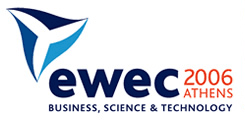
Short-term
forecasting - ANEMOS project
Workshops Track / Session Code: BW4
Tuesday, 28 February 2006, 16:00 - 18:00
Chair(s):
Thierry Langlois d'Estaintot, DG RTD, European Commission, Belgium
Philip O'Donnell, ESB National Grid, Ireland
 download
papers & presentations
download
papers & presentations
|
|
|
paper |
present. |
| BW4.1 |
Next
Generation Short-term Forecasting of Wind Power - Overview of the Anemos
Project. |
George
KARINIOTAKIS, Ecole des Mines de Paris, France. |
|
|
| BW4.2 |
Short-term
Forecasting Using Advanced Physical Modelling |
Gregor
GIEBEL, RISOE, Denmark. |
|
|
| BW4.3
|
Advanced
Statistical Modelling and Uncertainty Assessment for Wind Power Forecasting |
Torben
Skov NIELSEN,Technical University of Denmark, Denmark. |
|
|
| BW4.4
|
Short-term
Forecasting of Offshore Wind Farms Production |
Jens
TAMBKE,Univ. Oldenburg, Germany. |
|
|
| BW4.5 |
Evaluation
of Advanced Wind Power Forecasting Models |
Ignacio
MARTI,CENER, Spain. |
|
|
| BW4.6 |
The
ANEMOS Wind Power Forecasting Platform. |
Igor
WALDL, OVERSPEED, Germany. |
|
|
|
|
|
Posted by webmaster on Wednesday, March 15 @ 15:52:33 CET (6716 reads)
(Read More... | Official documents | Score: 0)

|
|
 | Official documents: Stand of the Anemos Project at the CER 2005 Exhibition |
 Untitled Document
Untitled Document
Communicating
European Research 2005
International Conference
Brussels Exhibition Center (Heysel)
14-15 November 2005
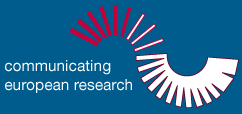
Views
of the Anemos Stand and the Exhibition Hall.
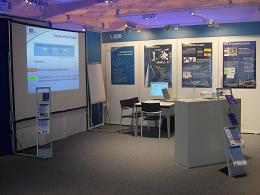
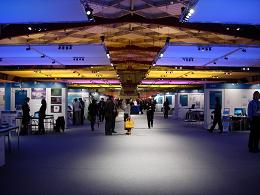 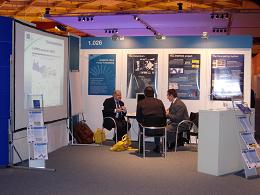
On
14-15 November, the European Commission’s Directorate-General for Research
hosted the second “Communicating European Research” Conference. Based
on the very positive experiences from the 2004 edition, the event focused on
the manifold aspects of science communication and provided an excellent forum
and meeting place for scientists, communication professionals and journalists.
The conference took stock of the way towards the Seventh Framework Programme.
|
The
ANEMOS project participated with a stand at the CER 2005 Exhibition.
|
|
|
|
Posted by webmaster on Wednesday, March 15 @ 15:14:26 CET (1423 reads)
(Read More... | Official documents | Score: 0)

|
|
 | Announcement: European Wind Energy at the dawn of the 21st century,Research funded under the 5 |
 Untitled Document
The European
Commission has published a brochure entitled: "European Wind Energy
at the dawn of the 21st century,Research funded under the Fifth Framework Programme".
Untitled Document
The European
Commission has published a brochure entitled: "European Wind Energy
at the dawn of the 21st century,Research funded under the Fifth Framework Programme".
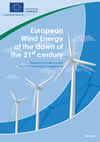
Download
the document
This brochure
provides an overview of research in the field of Wind Power, describing the
current state of the art and the results achieved in EU-funded research and
demonstration projects under the Thematic Programme ‘Energy, Environment
and Sustainable Development’ of the Fifth Framework Programme (1998-2002).
The projects, which have been compiled into six research areas, from turbine
technologies to demonstration of wind power applications, are summarised giving
the scientific and technical objectives and achievements of each, plus contact
details for the participating organisations.
|
|
|
Posted by webmaster on Tuesday, September 20 @ 23:14:23 CEST (1756 reads)
(Read More... | Announcement | Score: 0)

|
|
 | Announcement: Press Articles on Anemos Project |
 Untitled Document
Untitled Document
|
Article
at the Journal Systemes Solaires by Journalist Vincent Boulanger,
No 165, Jan-Feb 2005. |
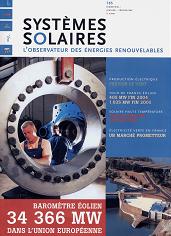 |
|
|
| |
|
|
Article
at the Modern Power Systems Magazine,
November 2004. |
|
|
|
|
|
|
|
Article
at the Journal Systemes Solaires by Journalist Benoit Carrigues,
No 153, Jan-Feb 2003. |
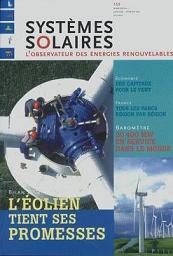 |
|
|
|
|
|
|
|
Posted by webmaster on Saturday, March 12 @ 01:57:51 CET (3410 reads)
(Read More... | Announcement | Score: 0)

|
|
 | Official documents: WP-5 description |
 Work- Package 1: "DEFINITION OF PREDICTION REQUIREMENTS
Work- Package 1: "DEFINITION OF PREDICTION REQUIREMENTS
|
Work-Package 5:
|
"Prediction Models for
Offshore Wind Farms".
|
| |
|
|
WP Leader:
|
Univ. OLDENBURG (Detlev Heinemann).
|
| |
|
|
Partners Involved:
|
ARIA,
ARMINES, CCLRC/RAL, CENER, CIEMAT, DTU, OVERSPEED, RISOE
|
Objectives:
This Work-Package aims to develop forecasting models for offshore wind farms.
In a given area of interest, offshore wind parks are currently located in the
5 to 10 km zones from coast. Considering the surface covered by wind farms,
the resolution of the wind grid needed is about 1 km. The data available for
offshore applications will be measurements at the level of wind farm as well
as Numerical Weather Predictions (NWP) provided by a meteorological system.
The downscaling of NWPs to the level of wind farm involves several difficulties;
for example due to the variable roughness of sea surface that depends on wind
speed. This Work-Package focuses on the specificities of the meteorological
conditions offshore. The roughness is very low, and the thermal state of the
atmosphere, the stability, is for long periods very different from the near
neutral case expected onshore. Additionally, the low roughness increases the
influence of stability on the wind speed profile dramatically. It is of interest
to investigate the parameters that influence the wind speed offshore most. In
a first step purely NWPs are evaluated against measurements.
Of special interest is the evaluation of meteorological forecasts by estimation
of wind speed on a kilometric grid from Satellite Radar data. Radar images from
open waters contain information about wind speed and wind direction. In contrast
to mast measurements, the absolute accuracy is quite poor (rmse ~2 m/s), but
spatial information for a large region can be delivered. This spatial information
about wind speed and direction can be used e.g. to validate shadowing within
the windfarm. Patterns of wind field around the wind farm can be defined from
Satellite images. It will be examined how this high-resolution information can
be integrated in either physical or statistical prediction models.
The ultimate objective is to develop statistical (i.e. artificial intelligence
based ones) and physical models able to perform accurately for the offshore
case. The physical models should be able to describe the vertical wind profile
for vertical refinement of the wind speed. Emphasis is given in modelling spatio-temporal
characteristics in large offshore wind farms. Offshore installed capacity will
be very concentrated. Therefore large power fluctuations will occur much more
often then onshore.
Description of Work:
|
Task 5.1: Impact of high-resolution meteorological forecasts.
|
|
Task 5.2: Contribution of satellite-radar information.
|
|
Task 5.3: Development of physical & statistical
models
|
|
Task 5.4: Modelling spatio-temporal characteristics
in large offshore wind farms
|
Project
flow-chart
Back to Task
Overview
|
|
|
Posted by webmaster on Saturday, October 09 @ 03:06:49 CEST (2295 reads)
(Read More... | Official documents | Score: 0)

|
|
 | Official documents: WP-4 description |
 Work- Package 1: "DEFINITION OF PREDICTION REQUIREMENTS
Work- Package 1: "DEFINITION OF PREDICTION REQUIREMENTS
|
Work-Package 4:
|
"Prediction using advanced
Physical Modelling".
|
| |
|
|
WP Leader:
|
RISOE (Gregor Giebel).
|
| |
|
|
Partners Involved:
|
ARIA,
ARMINES, CENER, CIEMAT, DTU, IASA
|
Objectives:
Short-term prediction is used operationally in a number of countries. The number
one complaint by the utilities that use the predictions operationally is that
the predictions are not of the same quality as they are used to from load predictions.
The short-term prediction models themselves (defined as the "translator"
of the NWP model results into wind power forecasts) are quite accurate if fed
with measured data. The models also reach a significantly better result than
pure meteorological forecasts. However, the main error source is the NWP model.
WP-4 tries to especially help out in cases of bad predictions, where the performance
of the NWP model for a particular site is not good enough.
The reasons for this less-than-adequate performance can be insufficient resolution
of the local flows, not good enough parameterisation of physical phenomena on
a scale below the grid resolution, a non-representative data source feeding
the model in the vicinity of the site, and a number of other (often large-scale)
effects. The main push in this WP is to use meso-scale and CFD models to capture
the sub-scale effects not resolved by the main NWP model. The main idea here
is that better forecasts of the worst forecasted sites leads to a higher quality
forecast for the areas, thus increasing the usability of wind power in a large-scale
grid and reducing the "ecological rucksack" of wind power.
Description of Work:
The aim of this work package is to improve existing physical
models or to elaborate more advanced ones for wind resource prediction especially
in complex terrain. The developed models will consider as input high-resolution
meteorological information. Due to the shortening of the modelled area, more
detailed models for the terrain will be developed. The Work Package will examine
the benefits from downscaling wind power using advanced CFD modelling.On the
other hand, multi-dimensional MOS correction matrix will be generated based
on a number of simulations with KAMM. This will increase the speed of a physical
model and will account for Mesoscale effects.Finally, the long-term (up to 7
days ahead) wind resource predictability will be assessed.
|
Task 4.1: Prediction in complex terrain. CFD modelling.
|
|
Task 4.2: Models based on high-resolution meteorological
information.
|
|
Task 4.3: Advanced MOS based on high-resolution meteo.
|
|
Task 4.4: Long-term wind resource predictability (up
to 7 days).
|
Project
flow-chart
Back to Task
Overview
|
|
|
Posted by webmaster on Saturday, October 09 @ 01:36:50 CEST (2380 reads)
(Read More... | Official documents | Score: 0)

|
|
 | Official documents: WP-3 description |

|
Work-Package 3:
|
"Development of Statistical
Models ".
|
| |
|
|
WP Leader:
|
DTU-IMM (Henrik Madsen).
|
| |
|
|
Partners Involved:
|
ARMINES,
CCLRC/RAL, CENER, IASA, ICCS/NTUA, UC3M, University of Oldenburg.
|
Objectives:
The objective of this Work Package is to develop accurate models for wind resource
forecasting based on advanced statistical and mainly on artificial intelligence
methods (i.e. fuzzy logic, neural networks). These techniques permit to combine
various types of explanatory inputs like wind direction, wind speed from neighbour
sites, numerical weather predictions etc. Statistical techniques are very promising
when high-resolution meteorological information is used as input to predict
wind production up to 48-72 hours ahead.
Emphasis will be given to the development of statistical power curve models
to estimate the relationship between wind power and local forecasts for meteorological
variables such as wind speed and direction. Experience so far shows that one
of the main error sources in wind power prediction lies in insufficient power
curves. The use of certified power curves does not guarantee that the relation
between wind speed and power output is accurately described. Models based on
artificial intelligence will be developed for statistical downscaling. This
consists in using a non-physical model for interpolating metrological forecasts
from the nodes around wind farm to the level of wind farm and height of wind
turbines. Statistical modelling can be an alternative technique to explicit
terrain and roughness modelling.
Tasks will be dedicated on the development of approaches for regional or national
forecasting of wind power (upscaling). Robust approaches for the on-line tuning
of prediction models will be developped and evaluated. Such methods will permit
adaptive models to avoid producing outliers in case of erroneous data input
or extreme wind conditions.
Description of Work:
|
Task 3.1: Development of advanced statistical prediction
models.
|
|
Task 3.2: Power curve modelling.
|
|
Task 3.3: Statistical downscaling.
|
|
Task 3.4: Upscaling.
|
|
Task 3.5: Automated processes for online tuning.
|
|
Task 3.6: Very short-term prediction for control purposes.
|
Project flow-chart
Back to Task
Overview
|
|
|
Posted by webmaster on Tuesday, September 23 @ 21:12:17 CEST (2757 reads)
(Read More... | Official documents | Score: 0)

|
|
 | Official documents: WP-2 description |

|
Work-Package 2:
|
"Off-line Evaluation of Prediction
Techniques".
|
| |
|
|
WP Leader:
|
CENER (Ignacio Marti).
|
| |
|
|
Partners Involved:
|
ARMINES, ARIA, UC3M, DTU,
MeteoFrance, CCLRC/RAL, RISOE, IASA, Univ-Oldenburg, CIEMAT.
|
Objectives:
The aim of this work package is double fold. Initially, existing models developed by the partners called hereafter as “base-line” models will be set-up for a set of case-studies defined in WP-1. Then, using sets of data, prediction results will be produced covering sufficiently long periods. The development of ANEMOS shell and database in WP-6 will provide the possibility to host the data and interface with base-line models so that these prediction results can be easily compared to models developed in the project, but also, in order to examine the performance of combined models. In a second stage, the off-line evaluation of the models developed in the project will follow. The results from base-line models will permit benchmarking and extensive evaluation of the benefits from the developments in the project. Appropriate case-studies will be defined in WP-1 to cover a wide variety of environments, flat and complex terrain, on and offshore wind farms; also different forecasting horizons, from minutes to days; and different spatial scales, from the wind farm to the region.
This work package will undertake the challenging task to compare output of meteorological models for a number of selected sites. The conclusions are expected to be very critical for selecting the appropriate NWP systems for wind forecasting applications using cost/benefit analysis.
Finally, appropriate criteria will be defined for the evaluation of the methods with emphasis to their performance in extreme weather conditions, as well as their robustness in on-line operation conditions. The evaluation of the performance of the applied techniques will be done in off-line mode, using the historical database created in WP1. The validation of the models in on-line operation will continue in WP6 after the installation of ANEMOS at the selected sites.
The results of this work package will be crucial for the development of the project. The error estimation methodology will be used throughout the life of the project in order to assess the performance of the different models. The test cases will provide results, which will be the guidelines to develop the prediction models.
Description of Work:
|
Task 2.1: Off-line evaluation of base-line models.
|
|
Task 2.2: Combination of the existing models.
|
|
Task 2.3: Evaluation of models developed in the project.
|
|
Task 2.4: Evaluation of purely meteorological forecasts.
|
|
Task 2.5: Development of appropriate error measures.
|
Project flow-chart
Back to Tasks
Overview
|
|
|
Posted by webmaster on Monday, September 22 @ 22:34:17 CEST (2518 reads)
(Read More... | Official documents | Score: 0)

|
|
|  |
| Calendar |  |
| Selected Links |  |
| 
|